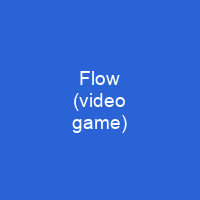Flow is an independent video game created by Jenova Chen and Nicholas Clark. In Flow, the player navigates a series of two-dimensional planes with an aquatic microorganism that evolves by consuming other microorganisms. The game’s design is based on Chen’s research into dynamic difficulty adjustment at the University of Southern California’s Interactive Media Division. The Flash version of Flow received 100,000 downloads within its first two weeks of release, and had been played over 3.5 million times by 2008.
About Flow (video game) in brief

The pack also includes new enemies, and new food types, and it also includes an option of eating or not eating any of the creatures in the game. Flow was originally developed as part of Chen’s master’s thesis for the Interactive Program at the University of Southern California’s School of Cinematic Arts. Chen described the game as simple; he allowed players to change the game’s difficulty by causing the player to react subconsciously to a situation in a way that he felt was best for the player. The player may decide to rush downwards to grow stronger before attacking any powerful opponents, or to dive between planes and dive at the option of attacking or not attacking any of them at all. In the Flash version, the players can replay the game with a jellyfish-like organism by defeating an aggressive creature on the bottom plane. If the player reaches the bottom again, the creature there is their original worm-like creature, and defeating it starts the game over as that organism. The PS3 version features enhanced visuals and three additional playable organisms: one that can move with a short burst of speed, oneThat can paralyze other creatures, one that lunges toward its prey’s weak point, and one that creates a vortex to attract small creatures.
You want to know more about Flow (video game)?
This page is based on the article Flow (video game) published in Wikipedia (as of Dec. 07, 2020) and was automatically summarized using artificial intelligence.







